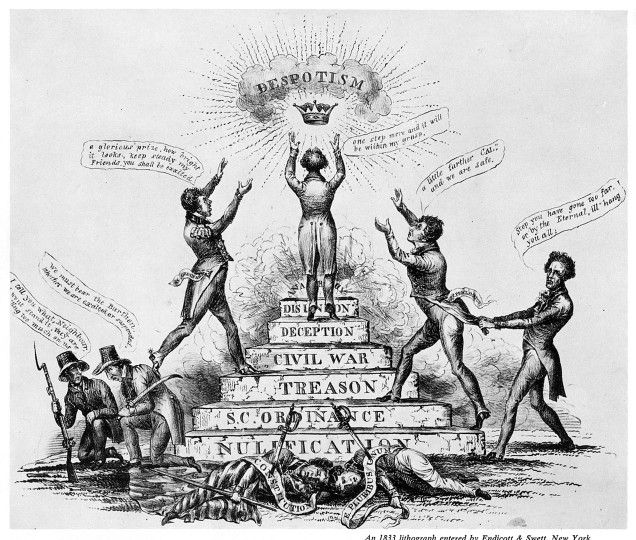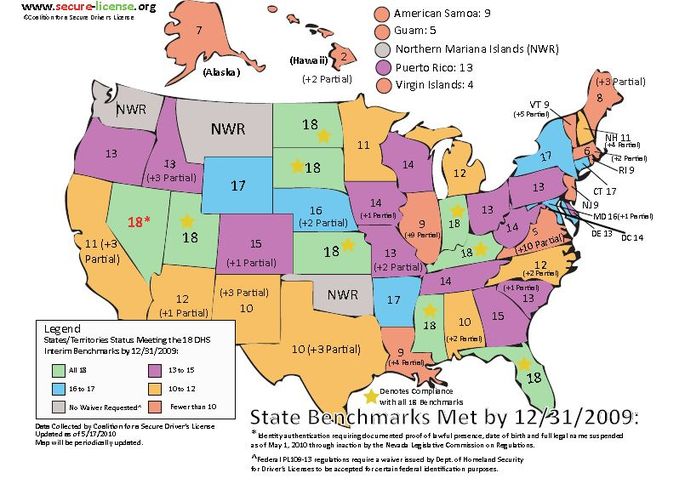This is Part 2 in a continuing series on nullification. For Part 1, click HERE.

- Nullification – only example of limited success occurred in 1832 – which clearly inspired this cartoon.
In Part 1, I explained that in the past year, I’ve come to realize that nullification is not a solution that should be pursued by the states. That change of opinion, the result of much research and reflection, includes a number of reasons.
The first I will give should convince even those who philosophically support the concept.
Historically, nullification has proven ineffective
While there are a number of examples available1 I believe there are two, in particular, that sufficiently make the case that nullification is ineffective: REAL ID and the health care law. This article deals with REAL ID. Part 3 will focus on health care implementation.
REAL ID…Identifies Nullification as a REAL Failure
Many people cite nullification by the states’ of REAL ID, an Act passed in 2005, as proof of its success. Civil liberty, sovereignty, and limited government advocates quite rightly labeled REAL ID as a move towards a national ID card. They also argued that it violates of a number of long-standing principles:
- Blurring of law enforcement’s traditional jurisdictional boundaries
- The original separation and balance of powers doctrine, which included the States through federalism2
- Particular inalienable rights articulated in the Fourth and Fifth amendments
The majority of state level bureaucrats and elected officials who objected to REAL ID did so almost solely on the basis of straining their state’s budgets – they said it was an unfunded mandate, and it was.
Most states refused to implement the Act, some passively, some actively through the passage of legislation 3. The proof “is in the pudding”, however. Real ID 4 has been implemented in various degrees within most states, including some who passed legislation (archived link) purporting to prohibit that very thing. THIS ARTICLE, by Oklahoma activist, Kaye Beach, provided an update in November, which illustrates plainly that nullification has failed to stop implementation.

- Image from DelawarePolitics.net
For people who live in states whose elected officials objected to REAL ID, several perplexing possibilities come to mind. Those elected officials were too much on their own in attempting to stop it, had little understanding of their states’ bureaucracy, or, worse, they were simply mollifying the constituents who objected by pledging that the actions they had taken were sufficient.
An examination of events in Nebraska should cause any thinking person to wonder: The Unicameral passed a resolution in 2007 (see footnote #3) urging Congress to repeal the REAL ID Act of 2005. It appears that no further action was taken by the Legislature until 2009, when a bill was introduced to bring the state into compliance with the REAL ID Act. But the only information I can find indicates the bill was indefinitely postponed and apparently died. There may be an information gap but I can’t currently close it. If Nebraska’s legislators subsequently voted to implement REAL ID, no one else tracking the issue seems aware of it. However, a Lincoln Journal Star article in July 2010 proves REAL ID implementation was underway at that point5 , causing a major backlog in getting people their licenses.
By believing that nullification was a solution, not only did efforts to stop REAL ID fail in Nebraska and other states, many fundamental issues associated with the whole subject were never addressed. Those include questions about the constitutionality of federal government commandeering state licensing procedures for its own purposes, implications for electronic collection of citizens’ personal information, sharing of data with third-party vendors, and compilation of information on the federal level that had previously been held within the state, among others. Moreover, there have been ongoing efforts to push identification requirements much further, and as this is being read, efforts are ongoing to embed biometric data and RFID technology in driver’s licenses in many states. Such developments are even more disturbing than the original REAL ID concept.
One a political level, opponents of REAL ID believed state-level elected officials and bureaucrats were both competent and well-intended. Officials who made objections on the singular premise of “unfunded mandate” were not called to account to make the best arguments. Sorting out the incompetent and ineffective from the purely politically-motivated did not take place. Therefore, none were properly monitored, scrutinized, nor lobbied with actually effective solutions. Many were re-elected to office.
The implication I am making is clear – elected officials who pledged nullification as a solution to the REAL ID implementation problem were ultimately fooling themselves and others or they were knowingly doing so for political gain.
______________________________
Lingering Questions…
- Why did it take until 2007 for the Nebraska Legislature to repudiate the REAL ID Act, which was passed by Congress in 2005?
- How did the implementation of REAL ID in Nebraska move forward absent legislative authority (such as for making necessary changes to state statutes and, very importantly, to authorize funding) or did the Legislature pass some measure missed by all of the watchers?
- Did the Department of Motor Vehicles directly apply for a federal grant to fund implementation?
- If our legislators had known what they were doing and had been serious about blocking the implementation of the law, instead of merely passing a resolution to be sent to Congress, what other steps might they have taken?
- Was Nebraska’s Governor totally on vacation?
- Where was the Attorney General?
Civil Disobedience vs Nullification
It’s very important to understand that blocking implementation of the REAL ID Act would have actually required (and actually did entail, for a while) some measure of civil disobedience from our state-level officials. The distinction between civil disobedience and nullification is very important. Civil disobedience is a deliberate choice to refuse to implement or obey a law, even if it does apply. Nullification rationalizes that individual states or, apparently, individuals may rightfully determine on their own that a law is unconstitutional. Civil disobedience should only be engaged in rarely, in extraordinary circumstances, and for a limited period while other available options are pursued.
Possibilities…
Nebraska officials, including the Governor, members of the Legislature, and the Attorney General should have worked together to devise and coordinate a specific action plan to respond to the passage of the REAL ID Act by Congress.
1) Passage of a resolution by the Legislature at the earliest available date following Congress’ action
2) Formal Request made to the Attorney General by the Governor or Legislature to review the federal law (see #5, below)
3) An issuance of directives by the Governor to his executive branch agencies explicitly prohibiting any action on implementing the law or requesting funding from the federal government for the purposes of implementation, at minimum, for a specified period while under review and/or litigation
4) No appropriation of funding for implementation or inclusion in the Governor’s submitted budgets
5) My research indicates there were ample grounds for a suit filed by the Attorney General. The 2007 resolution passed by the Legislature had strikingly similar language to that found in several Supreme Court rulings pertaining to federal government encroaching on states, particularly in this passage6:
“WHEREAS, the REAL ID Act wrongly coerces states into doing the federal government’s bidding by threatening to refuse noncomplying states’ citizens the privileges and immunities enjoyed by other states’ citizens;”
6) Due consideration to the necessity of broader action to protect from state encroachments. Considering the implications of REAL ID, this action by federal government, along with others should have provoked, at minimum, questions from state-level officials regarding the growing imbalance between the federal and state governments. See footnote7.
A REAL MESS
Based on the evidence as relates to REAL ID – nullification not only does not work – it creates a mess. This particular mess is now six years old and only getting bigger. One case in point is a map prepared by an entity which has been advocating for REAL ID. As of 12/31/2009, according to this group, most states had made significant progress in implementing the 18 benchmarks required by the REAL ID Act, including Nebraska, which had implemented 16 out of the 18.
Note the date on the map – as mentioned above – the bill in the Nebraska Legislature, LB229, to bring Nebraska in compliance with the REAL ID Act, by all accounts died in committee. If this map is accurate, how did Nebraska move toward implementation?
There is another issue – health care implementation – that is likely to go down the same path if people remain determined to focus on nullification as the answer.
The problems with advocating for nullification as a way of stopping health care implementation will be addressed in the next article in this series, Part 3.
- There are a number of historical examples that show nullification does not work. To preserve space within this article and to maintain focus on REAL ID, for the moment I will simply refer those interested in pursuing the topic further to an article on the Wallbuilders site written by David Barton in February 2010. I believe it is important to clarify that in linking to Mr. Barton’s article, I find some aspects of it problematic. For those who are truly interested in the history of nullification and interposition, I’d recommend using the timeline in Barton’s article as a basis for additional inquiry. Also, despite my caveats, Barton extensively cites primary sources. Those interested in an independent inquiry are encouraged to pursue those primary sources for themselves. ↩
- Under the U.S. Constitution as originally written, the States were a critical part of the balance and separation of powers because Senators were elected by State Legislatures, not by the people of their state – see Federalist 62. The 17th Amendment in 1913, which provided for election of US Senators by the people, removed a key element. It’s difficult to avoid a potential correlation between this disturbance in a balanced federalism and the increasing encroachment of federal government on states. ↩
- Nebraska was one of the States in which measures were introduced; LR28 was passed by the Nebraska Unicameral in 2007. In 2009, LB229, which sought to bring Nebraska into compliance with the law, was introduced, but my research indicates it was postponed indefinitely and not taken up again. As the information on this blog indicates, the Nebraska DMV proceeded with implementation absent legislative authorization. The site links to an article in the Lincoln Journal Star from July 15, 2010, which informs that Nebraska license applications – including those renewing – were all being sent to L-1 Identity Solutions, a third-party vendor. ↩
- Due to the blow back from states, the federal government had apparently been moving toward an alternative version of REAL ID, called PASS ID. However, it now appears that the Department of Homeland Security has reverted back to pushing for the original REAL ID program. ↩
- A personal experience provides some evidence that Nebraska moved to implement REAL ID in June of 2010; one of my children went to the DMV in Lincoln to obtain her first driver’s permit that month. It was at that point we learned that something had definitely changed about obtaining permits and licenses, although I did not at that time recall prior years’ media reports about REAL ID. My daughter was issued a temporary paper permit with a 30 day expiration and was told the new procedures meant the permanent card would be mailed. When the 30 day deadline was only days away, we called the DMV and were informed that problems with the new system had erupted, causing delays, and a new temporary would be issued. ↩
- The Printz v. United States case includes very similar language and in turn, references many previous cases upon which the Printz decision was based. The Court held that the federal government cannot impose a regulatory program or scheme on States, even temporarily. ↩
- There are no easy options and I will not explore all here. One I find appealing is a particular amendment to the US Constitution allowing 2/3 of states to repeal a federal law or regulation. Other options that occur to me are more political or would involve the associations and conferences of which many legislators and Governors are members. While I have not done any research, I have no recollection of more than a handful of candidates ever making REAL ID an issue at election time. ↩


You must be logged in to post a comment.